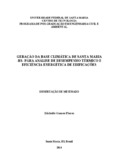| dc.creator | Flores, Michelle Gomes | |
| dc.date.accessioned | 2015-04-02 | |
| dc.date.available | 2015-04-02 | |
| dc.date.issued | 2014-07-17 | |
| dc.identifier.citation | FLORES, Michelle Gomes. GENERATION OF THE CLIMATE BASE OF SANTA MARIA -RS- FOR ANALYSIS OF THERMAL PERFORMANCE AND ENERGY EFFICIENCY OF BUILDINGS. 2014. 114 f. Dissertação (Mestrado em Engenharia Civil) - Universidade Federal de Santa Maria, Santa Maria, 2014. | por |
| dc.identifier.uri | http://repositorio.ufsm.br/handle/1/7862 | |
| dc.description.abstract | The treatment and the availability of climatological data are essential to the buildings
bioclimatic design. Energy efficiency can only be achieved when the plan considers local
weather specificities. This study contributes with the subject through the systematization of
climate data for the region of Santa Maria, RS. The data were collected to generate the Test
Reference Year (TRY), the Typical Meteorological Year (TMY), the bioclimatic chart (via
Analysis Bio and Psychros software), weather files compatible with programs such as
EnergyPlus and Design Builder, the diagram of winds (wind rose) elaborated by the software
Analysis SOL-AR and the typical day of project. Some of these systematizations already
existed but they were related to a lower period of years. The study inputted hourly data of
twelve years (2002 to 2013) and updated the data treatment methods. The files generation was
based in a scientific bibliography and methodologies that have been employed by research
groups concerned with the issue, such as works developed by Duffie and Beckmann (1980),
Goulart (1993), Pereira (2004), Carlo and Lamberts (2005) and Roriz (2012). The results were
conformed in a language accessible to designers and other agents in order to promote its
effective use for better energy efficiency and comfort of building users in Santa Maria s
region. Is was obtained 28,5% of comfort and 71,5% of discomfort. The ventilation is the
main strategy for the summer, with 18,4%. For the cold, the solar heating, with 29,4%, is the
best percentage. In relation to the summer winds direction, the predominant orientation is
east. Therewith, the major importance of this research is in the knowledge of bioclimatic
guidelines that help architects and engineers in architectonic propositions adjusted to the
clime, besides the availability of climate files for thermo-energetic simulation. | eng |
| dc.format | application/pdf | por |
| dc.language | por | por |
| dc.publisher | Universidade Federal de Santa Maria | por |
| dc.rights | Acesso Aberto | por |
| dc.subject | Dados climatológicos | por |
| dc.subject | Arquitetura bioclimática | por |
| dc.subject | Eficiência energética | por |
| dc.subject | Climatological data | eng |
| dc.subject | Bioclimatic architecture | eng |
| dc.subject | Energy efficiency | eng |
| dc.title | Geração da base climática de Santa Maria – RS – para análise de desempenho térmico e eficiência energética de edificações | por |
| dc.title.alternative | Generation of the climate base of Santa Maria – RS – for analysis of thermal performance and energy efficiency of buildings | eng |
| dc.type | Dissertação | por |
| dc.description.resumo | O tratamento e a disponibilização de dados climáticos para o projeto bioclimático de
edificações são fundamentais. A eficiência energética só pode ser atingida quando o projeto
considera as especificidades do clima local. Este estudo contribui com o assunto através da
sistematização de dados climáticos para a região de Santa Maria, RS. Os dados foram tratados
de forma a gerar o Ano Climático de Referência (TRY) e o Ano Meteorológico Típico
(TMY), a carta bioclimática (através dos programas Analysis Bio e Psychros), arquivos
climáticos compatíveis com programas como o EnergyPlus e Design Builder, o diagrama de
ventos (rosa dos ventos) elaborado pelo software Analysis SOL-AR e o dia de projeto típico.
Algumas dessas sistematizações já existiam, porém em um período de anos inferior. O estudo
incorporou dados horários de doze anos (2002 a 2013) e atualizou os métodos de tratamento
de dados. A geração dos arquivos baseou-se em bibliografia científica e metodologias que
vêm sendo empregadas por grupos de pesquisa envolvidos no tema, como em trabalhos
desenvolvidos por Duffie e Beckmann (1980), Goulart (1993), Pereira (2004), Carlo e
Lamberts (2005) e Roriz (2012). Os resultados foram conformados em uma linguagem
acessível aos projetistas e outros agentes a fim de promover seu efetivo uso na melhor
eficiência energética e conforto dos usuários de edificação da região de Santa Maria. Obtevese
28,5% de conforto e 71,5% de desconforto. A ventilação é a principal estratégia para verão,
com 18,4%. Para o frio, o aquecimento solar, com 29,4%, é a maior porcentagem. Em relação
à direção de ventos de verão, a orientação predominante é o leste. Com isso, a grande
importância dessa pesquisa está no conhecimento de diretrizes bioclimáticas para auxiliar os
arquitetos e engenheiros em suas propostas arquitetônicas adequadas ao clima, além da
disponibilidade de arquivos climáticos para simulação energética. | por |
| dc.contributor.advisor1 | Grigoletti, Giane de Campos | |
| dc.contributor.advisor1Lattes | http://lattes.cnpq.br/9725292275606192 | por |
| dc.contributor.referee1 | Carlo, Joyce Correna | |
| dc.contributor.referee1Lattes | http://lattes.cnpq.br/9467821670419268 | por |
| dc.contributor.referee2 | Santos, Joaquim Cesar Pizzutti dos | |
| dc.contributor.referee2Lattes | http://lattes.cnpq.br/6591314076760539 | por |
| dc.creator.Lattes | http://lattes.cnpq.br/2149356064262734 | por |
| dc.publisher.country | BR | por |
| dc.publisher.department | Engenharia Civil | por |
| dc.publisher.initials | UFSM | por |
| dc.publisher.program | Programa de Pós-Graduação em Engenharia Civil | por |
| dc.subject.cnpq | CNPQ::ENGENHARIAS::ENGENHARIA CIVIL | por |


